| |
Pictures with blue borders are thumbnails - click on the
picture to bring up the full-sized picture
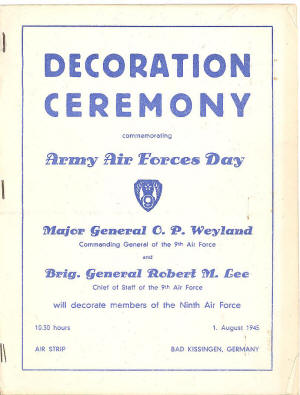
The souvenir program from the 9th Air Force Decoration Ceremony held
at Bad Kissingen on 1 August, 1945 - the document that led us to
Major Katherine Saint John.
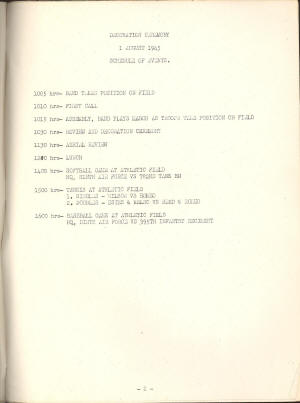
The schedule of events for the day …
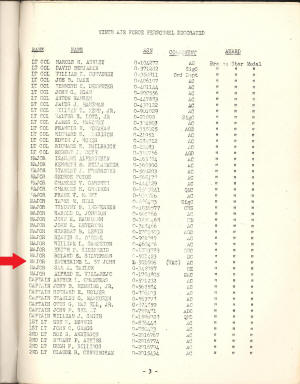
And first page of the awardees. Major Saint John is
highlighted.
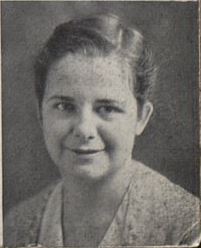
Katherine Smith, University of Kentucky, Class of 1931.
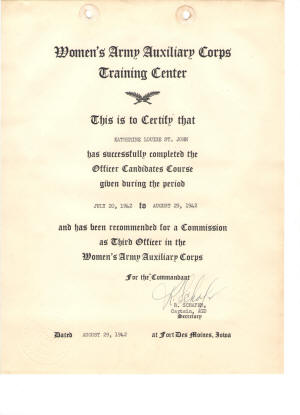
Now with the married name of Katherine Saint John, her commissioning
document as a Third Officer in the Woman’s Army Auxiliary Corps.
WAACs ranks were regularized to the standard Army structure in 1943
when the Woman’s Army Corps was recognized as a branch rather than
an auxiliary organization.
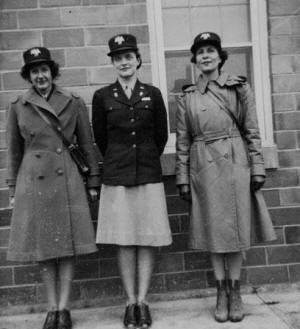
Examples of WAC uniforms in England 1943.
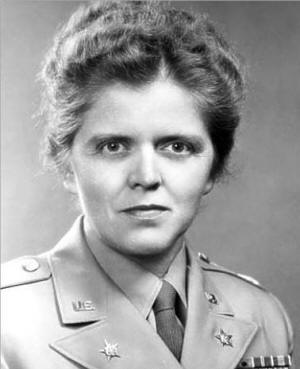
Colonel Mary Hallaren, Katherine’s boss and mentor
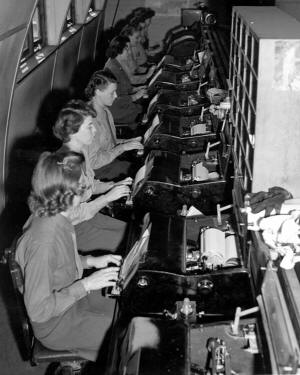
WACs at work in 9th Air Force
communications banks,
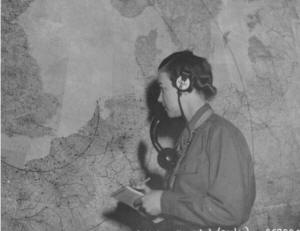
And at bomber mission plotting boards.
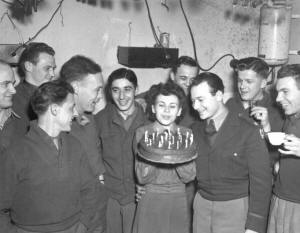
WAC fraternization was not particularly discouraged - with women
working along side men in staff and communications sections,
friendships soon blossomed.
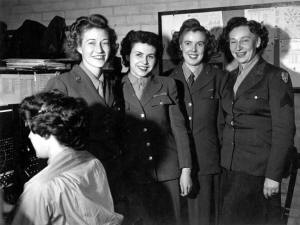
The Air Force has a good selection of images related to the 9th AF
WACs, particularly when they were stationed in England,
unfortunately there were no images of Major Saint John.

The WAC Company attached to the 9th Bomber Division. Major
Katherine Saint John was a frequent visitor to the unit checking on
morale, order and organization.
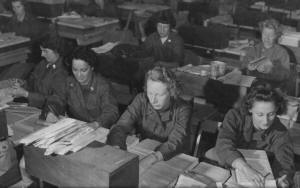
An Army postal sorting unit, one of the first units that featured
all WACs and a female chain of command taking full operational
responsibility.
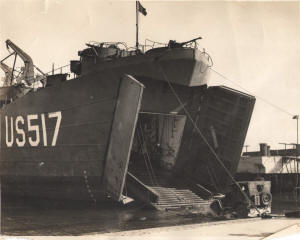
The HQ of the 9th Air Force landing in France, 1944 …
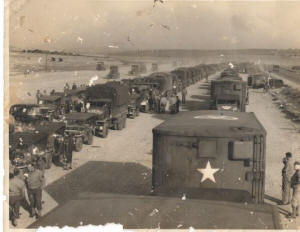
Getting organized and heading east.
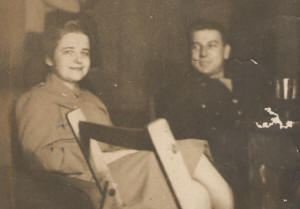
Major Katherine Saint John and Major James Atkinson, they would
marry in Wurzburg in 1945 while both were stationed at Bad Kissingen.
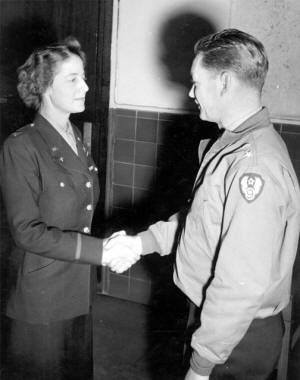
Captain Stein, commander of the WAC Detachment - 9th Bomber
Division, congratulated by 9th USAF Commander, MG Weyland, near the
end of the war.
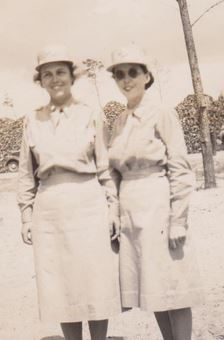
WAC summer uniforms, probably similar to what Major Saint John would
have worn at the Kissingen Awards Ceremony.
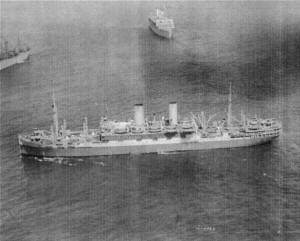
Athos II configured as an Army transport ship.
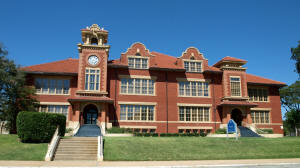
Blinn College Old Main Hall
Blinn College Site
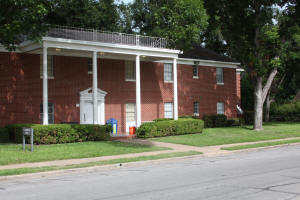
Katherine Atkinson Hall, Blinn College.
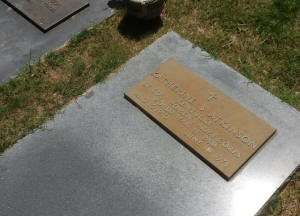
|
|
|
Decoration Ceremony
On 6 June 1945, the Headquarters and Headquarters elements of the
9th US Air Force, moved from their base in Chantilly France to Bad
Kissingen, Germany. The 9th had been providing direct fighter,
medium bomber and air transport support to US forces on the attack
first in Africa, then in England flying across the channel into
France and finally during the dash through Western Europe after the
invasion. The unit that had pioneered close air support of troops
was not designated for the continuing war in the Pacific, but rather
would be radically reshaped and take on a new role in the occupation
force.
How the
command specifically landed the Bad Kissingen location is
open to speculation but the 9th’s Commander,
Major General O.P. Weyland , certainly had clout and
with the Army divisions so scattered across Germany, Austria
and Czechoslovakia quickly readying for redeployment to
either the Pacific or return to the United States, Bad
Kissingen, fully intact, was available and quite a plumb for
the taking. The central downtown hotel district was
cordoned off, the headquarters unit moved in and Germans
necessary to provide support to the area put on a curfew and
pass system.
The dozens of fighter and bomber wings, transport squadrons and then
all the associated battalions and companies of engineers,
logisticians, anti aircraft and communications units that comprised
the command were arrayed across southern Germany and that Summer of
1945, were almost uniformly disassembling themselves and readying
the personnel for return to America. At Kissingen, the Headquarters
was busy enough but with new tasks - writing after action reports,
disposing of aircraft and monitoring the preparations of departing
personnel. There was ample time for celebrations and awards
ceremonies in the warm Summer sun.
“ Persons to be
Decorated and Colors - Center - March! “
1 August 1945 was a Wednesday and in the short lived history of the
Army Air Force, had been designated as Army Air Force day - a day
that unit commanders were encouraged to commemorate with organized
celebrations. At Kissingen, the day was event filled with an awards
ceremony, an air parade, unit festivities including a special lunch
and then organized athletics. Officers and men could spend the
afternoon watching the Headquarters 9th AF baseball and softball
teams challenge rivals, the top tennis talent in the command squared
off on the town’s clay courts. On the whole, not a bad mid week
break for the troops.
The day began with the Decoration Ceremony and without doubt, there
had been a few rehearsals at the small airfield just west of town
earlier in the week. Major General Weyland and his Chief of Staff,
BG Robert M. Lee were the senior figures on hand and this
ceremony was somewhat special, the personnel receiving awards were
solely from the 9th Headquarters command.
Throughout the earlier part of the Summer, as flight squadron after
squadron stood down, these two Generals had attended dozens of such
events across southern Germany; no pilot, crewman or mechanic
seemingly went home empty handed. The medals and commendations were
frequent and well deserved and the awards ceremony at Kissingen
appears to have been one of the last ones on the schedule. Fitting
that it should fall on Air Forces Day.
A total of 97 personnel were assembled at the airfield at 10.30 to
receive the Bronze Star for Merit, and among them were 52 officers,
2 warrant officers and 43 enlisted men. There were 16 lieutenants
colonel and 16 staff sergeants in the group; there were three
privates first class.
Researching the names of the awardees found on a souvenir program, a
number of interesting finds. One officer, a briefing and public
affairs specialist, later founded a major public relations firm
after the war. Another officer, after twelve years active duty,
went on to a top science graduate school and spent forty years as a
senior scientist with IBM. There was a physician and flight surgeon
in the group - at 97 years of age, the only survivor we could
locate. He may not recall the awards ceremony but greets each new
day with a smile. One of the junior NCOs recognized found a
wonderful new job buying, selling and racing horses across the south
and southwest. Thoroughbreds - not really, he was quoted that he
took more joy in a five dollar horse winning at the county fair than
the exploits of a thousand dollar horse he once ran at the Stockton
Downs. A lot of compelling guys with great stories, and then there
were the women.
In the group of awardees was an unexpected find, six members of the
Women’s Army Corps, WACs. There were five enlisted and one officer,
Major Katherine L Saint John and here lies a story to be told. She
was the senior WAC in the 9th Air Force at war’s end and without
doubt the most senior military woman to receive an award while
stationed at Bad Kissingen. She has as compelling a story as any of
the men she stood with on that summer day; let’s meet Katherine
Saint John.
Extraordinary Women
Commonly Found
Katherine Smith was born into an upper middle class family on 16
August 1910, in Frankfort Kentucky. Her father David D Smith was
the local long serving mayor and as Americans embraced the new
century - much was expected in that household. As she was growing
up, the public role and status of women certainly would have been a
topic of conversation. Kentucky was a state that early on, had
granted suffrage, the right to vote, to women under certain
circumstances. The legislation was repealed and a few years later,
restored. Needless to say, the debates were long and passion
filled.
Kentucky women were also very publicly involved in the temperance
movement and it was said in that state that “ If you were a woman
and had an opinion you might as well say it and say it loud and then
stand by it. “
Katherine graduated from the University of Kentucky in 1932. She
attended the College of Arts and Sciences and participated in the
Woman’s Pan Hellenic Club - a student organization interested in the
role of women in government and politics. Katherine was a member
and then President of the Kappa Kappa Gamma sorority, one of the
oldest Greek letter female student societies. The KKG motto was, “
Aspire to Be. ”
Her first real post college job was teaching a forth grade class in
Frankfort but she was already well known in the region. While in
college, she and her father would serve as social stand - ins for
the Governor of Kentucky, at events he chose to avoid. On the
personal side, there was a growing romance with an Army officer.
Yes - there was talk of marriage and the formal announcement of an
engagement was in the offing but he was tragically killed in an
accident and for Katherine, it was time for a change.
She vacationed in Alaska and then cruised down the coast to Panama.
Shipboard, she met an old classmate, John Saint John and they
married but it was a brief and unhappy affair. Upon returning to
Kentucky, the marriage was over but Katherine retained the Saint
John last name. She tried her hand at political reporting for a
local newspaper, was successful but still felt unfulfilled.
As America entered the war in 1942, a part of the general
mobilization of society included the formation of a
Woman’s Army Auxiliary Corp, an idea long considered that
finally came to pass with the bombing of Pearl Harbor. Recruitment
efforts sought capable women of all backgrounds with the highest of
moral standards and accommodations were made for special Officer
Candidate Programs. Katherine Saint John enlisted and joined the
second OCS class. This class considered itself lucky - all of the
graduates of the first class remained stateside during the war,
filling the WAC training and cadre positions - members of the
second class were the first WACs actually deployed overseas.
For a capable WAC, promotion came quickly and Lieutenant Saint John,
assigned to the Supreme Headquarters Allied Expeditionary Forces,
SHAEF, was soon on the list for advancement. Her adult children
recall their mother’s stories from this period - at Headquarters in
England, she met most of the Allied generals who would go forth to
win the war: Patton, Montgomery, Eisenhower, Bradley and Mark
Clarke were commonly encountered. She even met Winston Churchill
and the King of England, George VI. This was all well and good, but
she was eager for a better opportunity.
WACs were
formed into their own units for living and administrative
purposes up to the size of a battalion with a female chain
of command. Once deployed overseas, units were then
attached to major commands with personnel dispersed into a
variety of administrative, communications and logistic
positions. The all female chain of command existed to
organize the basic living arrangements while supervision of
daily duty responsibilities fell to the male chain of
command. No WAC officers commanded males during the war and
senior WACs often had the title of “ supervisor “ or “
director “ attached to their name.
As the war progressed and more and more WACs entered the European
theater, certain all female units took full operational
responsibility with their own chain of command. For example, much
of the Army’s mail censorship, sortation and flow came to be handled
by all female units.
9th Air Force
In 1943, The 9th Army Air Force deployed from North Africa to
Southern England and began offensive air operations over France and
Belgium. While the 8th Air Force, with fleets of B17 bombers
tackled the strategic targets, German cities and heavy industries,
the 9th was configured with medium bombers and ground attack
fighters of every type. Their mission was to be much closer and
personal with the enemy. When first fitting out for this mission,
staffs rapidly expanded and the 9th came to be one of the most
prolific users of WAC personnel during the war.
The Army had expected the WACs to be good at clerical and
administrative tasks operating far to the rear and the 8th Air Force
took advantage of their skills but there was true surprise at just
how many jobs they successfully filled in the 9th Air Force. Vast
banks of voice and teletype communications equipment were soon
staffed by women, plotting boards that tracked attack missions were
a specialty and logistics operations in theater, from both the
clerical side to the actual picking, packing and shipping of parts
soon became their responsibility. Seen through modern eyes, this
hardly seems exceptional, but in 1944, it was quite noteworthy.
Lieutenant Saint John saw her chance, she applied and was accepted
for a transfer to the 9th Air Force.
Earlier, while still at SHAEF, Katherine would have encountered one
of the great pioneers in the WACs, Captain and then
Major Mary Hallaran , commander of the first WAC battalion sent
to England. They shared very similar backgrounds, both had been
teachers in civilian life, had a wild sense of adventure and now
were committed to insuring the success of the WACs in the Army Air
Corps. As the WAC battalion personnel were attached throughout the
8th and 9th Air Force, Major Hallaran was named director of WAC
Personnel in these commands and Captain Saint John made her deputy
and in this capacity was the senior female inspector for women in
the command.
With the invasion of France in June 1944, the 9th Air Force fighters
and bombers pressed to keep close to the troops they supported. In
rapid order they moved to forward bases in France and headquarters
echelons soon followed including Captain Saint John. Her son Jim
recalled highlights of stories his mother told of the advance across
France and then pressing the war closer to Germany.
“ She would speak of the US break out from Normandy at Saint Lo and
how they rattled along in jeeps not too distant from the actual
fighting and later, after the Allies had taken Paris, how she
marched in one of the grand victory parades. When the HQ 9th USAF
planned to jump to Chantilly in central France, Katherine and a
staff section were the advance party to help establish the new HQ.
They arrived in jeeps and trucks only to discover that the local
German units had only recently departed and that Patton’s armor
units, fast on their tale, had not quite arrived. When the tanks
passed through the town a few hours later, they were more than
surprised to find the WACs had led the way. Another story recalled
the dark days of the Battle of the Bulge and how rumors swept about
that German parachutists were in the vicinity. Despite the battle,
some of the officers of the headquarters had planned a Christmas
party and Katherine and other WAC officers were invited. They made
their way on floors of staff cars as their male peers kept watch for
ambush in the night. “
Captain Saint John appeared in American newspapers at about this
time. In a syndicated story, it was reported that two enlisted WAC
personnel at Chantilly had found boyfriends in the ranks and their
weddings were approved. Katherine was more than happy to “ give the
brides away “ at the ceremonies.
There was another story that lived in family lore. In letters
retained by her sons, Katherine mentioned that early on, she been
selected for the Bronze Star for Merit but had declined the award.
She simply felt that not enough had been done and the war was still
on. But beyond efficiency, there are affairs of the heart.
Romance in the ETO found Katherine as she and Major James H.
Atkinson, the Headquarters 9th USAF ground transport coordinator
fell in love and were engaged in December 1944.
Early in 1945, LTC Mary Hallaran was named Supervisor of all WAC
Personnel in the European Theater and Major Katherine Saint John
became senior supervisor of WACs in the 9th USAF. She is mentioned
several times in the unit history of the 9th Air Division, the
command structure organizing the medium bomber wings of the 9th USAF.
This air division had a WAC detachment of over 100 women serving as
plotters, clerical staff and communicators and Major Saint John
visited frequently on both formal unit inspections and informal
stops to check morale. Elsewhere across the 9th Air force network
of bases and units, Katherine would have been a frequent visitor to
a second large WAC detachment working at six Tactical Air Depots,
funneling repair parts to the squadrons and wings.
When the Headquarters 9th USAF departed Chantilly for Bad Kissingen,
Major Saint John accompanied it and interestingly, many of the WACs
she had supervised were fast departing Europe. The majority of WACs
assigned to the Ninth Air Division never deployed further west than
Chantilly and likewise, the second large detachment working
logistics remained in France. As a senior staff officer, Katherine
accompanied the command on the move east into Germany but how many
females actually accompanied her is unknown.
In late July 1945, at Bad Kissingen, there were always things to
do; LTC Hallaran was lobbying Katherine to stay in the Army and
there was talk of her involvement in a wider WAC After Action Report
and formal history of their involvement in the 9th USAF. There was
that Decoration Ceremony on the first of August and also later that
month, her marriage to Major Atkinson planned to be held at
Wurzburg. Then there was the matter of finding accommodations and
counting the days until redeployment to America.
High Seas
The 9th Air Force closed out its Headquarters in Bad Kissingen on 1
December 1945. Just how many personnel had remained for the final
ceremonies is not known but it appears as though Major Saint John,
now married but retaining the previous name for the time being, was
one of the last to depart and as dynamic as ever, she turns up again
in the newspapers.
The liner Athos II had been laid down in Germany in the mid 1920s
and then turned over to France as part of war reparations. It served
the cruise industry and in the 1930s, was reconfigured as a French
troop ship. In 1942, the ship was seized by American forces in
Algiers, was re - flagged under an American banner and put to use as
an American troop ship. Athos was loading personnel in La Harve in
December 1945 and among the 3500 embarking personnel were 212 WACs
under the command of Major Katherine Saint John. The journey proved
to be eventful.
After a stop at South Hampton to pick up additional passengers, the
she set across the Atlantic. Storms were not uncommon but the
weather situation began to deteriorate seriously on the 18th of
December and by the 21st, the ship was caught in a huge Atlantic
gale. The rudder suffered severe damage and the crew could no
longer keep the bow into the wind. This left the ship rolling
severely and sustaining further damage. Almost all of the life
boats were washed away, windows and hatches were smashed and finally
one of the two engines stopped. The ship was now rolling a total of
55 degrees.
In an emergency attempt to stabilize the vessel, the Captain ordered
passengers, including all the WACs, into the lowest central
passageways of the ship, creating a new, human center of balance on
the keel line. It worked, the ship stabilized and the storm abated
sufficiently for the Athos to limp to the Azores. Here the
passengers, along with the personnel of a second US troop ship
similarly battered by the storm, were loaded on board the US carrier
Enterprise, for the final leg of the trip to New York. Period
newspapers included this account by Katherine and others,
“The storm hit on December 21 at 1.30 PM while we were having our
date hour in the Officer’s Lounge “ Major Saint John said. She
explained that the date hour was a four hour period held each day
for WAC and Army enlisted personnel on board to socialize. “
“ Soldiers, WACs and furniture were tossed all over the place, “ she
continued. “ There was no hysteria at all when the WACs were ordered
below as ballast. One girl fainted and one girl suffered a broken
bone. Another girl had all of her front teeth knocked out. Orange
juice and eggs and mashed potatoes were all over the place and much
of our food was ruined.”
The article continued with other soldiers quotes recalling the storm
and the fact that about thirty personnel required medical attention
as they were loaded on to the Enterprise. The carrier finally made
it to New York on 23 January 1946 sailing through plumes of water
from harbor fire boats. This was the first time an American
aircraft carrier ferried female personnel.
Pregnant with their first child, Major Katherine Saint John formally
adopted the family name of Atkinson as she separated from the Army a
few weeks later at the brevet rank of lieutenant colonel.
Setting Sail for
Texas
Katherine and James Atkinson moved to Texas, his home, where he was
able to resume his career as a teacher and football coach. A
friend, Tom Spencer, helped land the job of Principal at Cypress
Fairbanks High School near Houston and then one year later, the
Atkinson family followed Tom to Blinn Junior College somewhat
further to the northwest. In quick succession, James was the
football coach, Athletic Director and then College Dean. By 1957,
he was the President of the College and held that position until
1991.
|
Click on the thumbnail
to view the full-sized picture
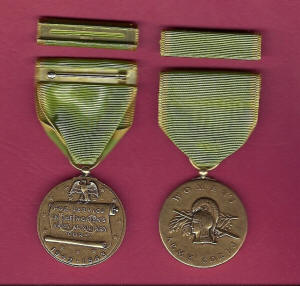
Medal awarded to WACs who were on duty when converted from the
auxiliary status to the Woman’s Army Corp status. |
Jim Atkinson, adult son of Katherine and James recalled his mother’s
post Army life at Blinn.
“ You had asked what mother did following the war. I may have made
it sound a little bland. Her life full but was short. She only lived
another 26 years passing away suddenly - 2 months short of her 61st
birthday in 1971.
|
Click on the thumbnail
to view the full-sized picture
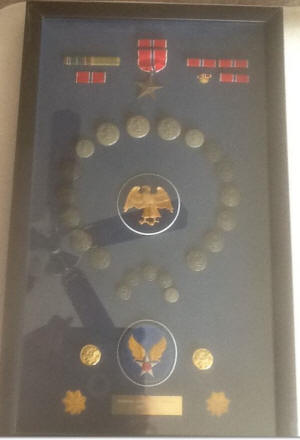
Medal display retained by the adult children of Katherine Atkinson
containing buttons from her Class A uniform, cap badge, shoulder
patch, Oak Leafs, Bronze Star medal and ribbons, Victory in Europe
and WAC Service ribbons. |
She was active in the Daughters of the American Revolution, the
local library association, and with her church. Politics was a
passion and she worked hard to elect democratic candidates on the
local, state, and national levels. She was at home in a local
campaign or in the Governor's office. Many a dignitary could be
found in our dining room stopping by to have a cup of coffee, some
of her famous candy, or just to visit in a comfortable atmosphere.
As the wife
of the President of the local college she took on the role
of ‘ first lady ’ with relish. On many days you could find
her walking the campus and visiting with the students,
encouraging them to succeed, and comforting those who were
homesick. She took the students under her arms just as she
had done with the WACs within her command. Within the region
she was known for her ability to make books come to life and
her ability to speak to audiences small and large and she
was named Washington County: Woman of the Year in
recognition of all she had done at both Blinn and in the
surrounding area, an award she was particularly proud of.
If someone had a need she was there. Race or status was not a
consideration. Her two boys were her love only surpassed by her
devotion to her husband. “
During the many years that Katherine and James were at Blinn, the
college experienced enormous growth opening satellite campuses and
offering ever expanding programs tailored to prepare men and women
to continue in the Texas university system or find fulfilling
careers with an Associates Degree.
Among the many honors the college has bestowed on Katherine and
James Atkinson, each has a dormitory named after them and there are
several scholarships in their names recalling their service to the
college. Blinn would not be what it is today were it not for their
efforts.
Coda:
The WACs honored at the 9th USAF Decoration Ceremony held at the Air
Field - Bad Kissingen on 1 August 1945 were:
In 1978, the Woman’s Army Corp was disbanded with all female
personnel integrated into the units to which they had been attached.
In 2012, the Army expanded the specialties and billets available for
female personnel to include service in most combat units.
As of April 2013, a total of 143 female personnel had been killed in
Iraq, Kuwait and Afghanistan.
June 2014 |
|